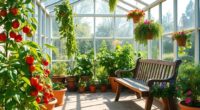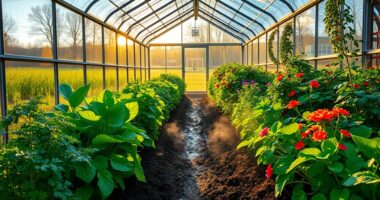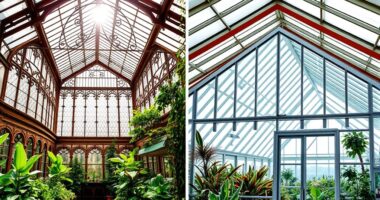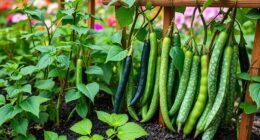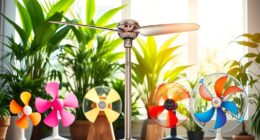Choosing the right greenhouse depends on your needs and space. Freestanding greenhouses offer flexibility, while Gothic arch designs provide durability and efficient heat retention. If you’re a beginner, A-frame structures are easy to manage, whereas hoop houses are cost-effective and great for diverse crops. Dome greenhouses offer energy efficiency and stability. Each type has its benefits, so consider your climate, crops, and maintenance preferences to make the best choice. Discover what suits you best as you explore further.
Key Takeaways
- Assess your available space and sunlight exposure to determine the best location for a freestanding greenhouse or specialized designs like hoop houses.
- Consider the climate in your area; gothic arch and dome greenhouses are ideal for harsh weather conditions and year-round cultivation.
- Evaluate your budget and desired durability; hoop houses offer a cost-effective solution while gothic and dome greenhouses provide long-term resilience.
- Identify the plants you want to grow; certain shapes, like A-frame and deep water culture systems, cater specifically to leafy greens and herbs.
- Think about your gardening experience; A-frame greenhouses are beginner-friendly, whereas more complex systems may require advanced gardening knowledge.
Freestanding Greenhouses
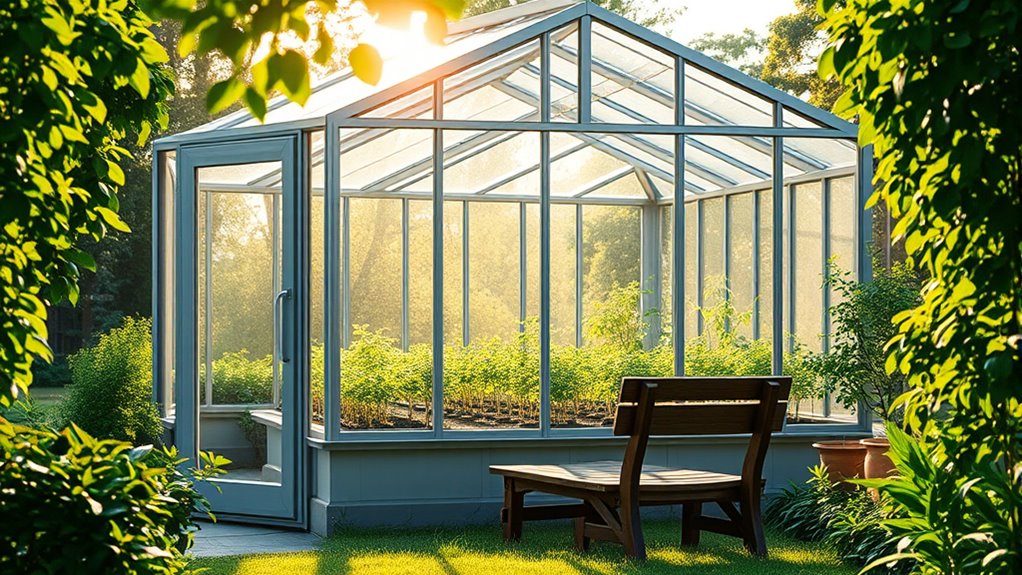
Freestanding greenhouses are versatile structures that stand alone, offering you the freedom to position them anywhere in your garden for optimal sunlight.
These independent buildings come in various shapes, like quonset, gable, and gothic roofs, each providing unique benefits. Gable styles maximize space, while quonset designs are budget-friendly.
Freestanding greenhouses offer diverse shapes like quonset and gable, maximizing space and catering to budget needs.
You’ll appreciate the flexibility to create distinct growing environments, accommodating different plants and conditions. Plus, the independent nature of these greenhouses ensures better airflow and ventilation, enhancing plant health.
With materials like aluminum, wood, and PVC available, you can find a structure that fits your aesthetic and functional needs.
Whether for personal or educational use, freestanding greenhouses truly adapt to your gardening ambitions.
Gothic Arch Greenhouses
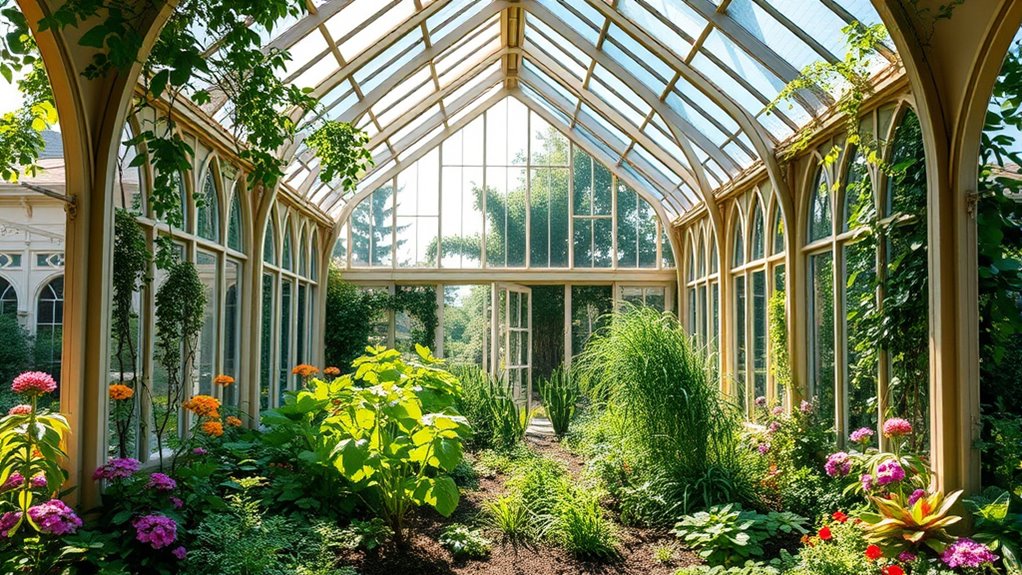
Gothic arch greenhouses stand out for their elegant design and practical benefits, making them a popular choice among gardeners.
Their unique curved shape provides structural support while enhancing aesthetic appeal. The half-teardrop roof effectively sheds snow and rain, preventing load issues, while ensuring uniform light distribution for optimal plant growth.
With high air volume capacity, these greenhouses maintain heat efficiently, lowering your energy costs. They’re durable enough to withstand harsh weather, allowing for year-round cultivation of various plants.
Plus, their modular construction enables easy assembly and customization to fit your space and budget.
Choose a gothic arch greenhouse for a sophisticated, energy-efficient solution that boosts your gardening efforts.
A-Frame Greenhouses
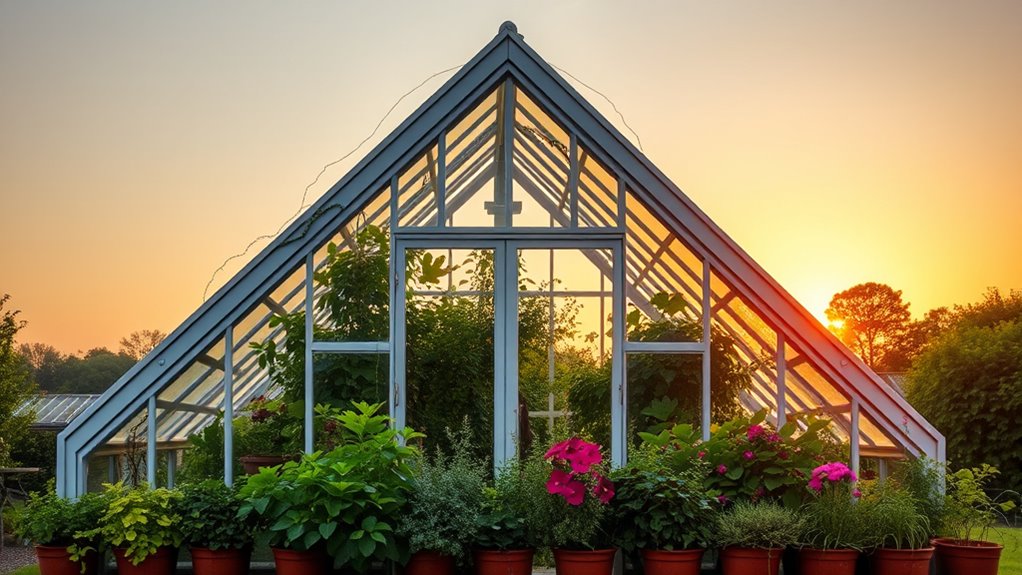
A-frame greenhouses offer a perfect blend of form and function, making them an excellent choice for gardeners of all skill levels.
Their triangular shape provides natural structural integrity, making construction straightforward, even for beginners. You can use materials like lumber or polycarbonate panels for durability and light diffusion.
With excellent ventilation and ample natural light, these greenhouses are perfect for your plants. The steep roof efficiently sheds snow and rain, ensuring weather protection.
Plus, their rustic charm allows them to blend beautifully with your landscape. Whether you’re gardening year-round or need a space-efficient solution, A-frame greenhouses are versatile and cost-effective, providing a practical option that enhances your gardening experience.
Hoop Houses

If you’re looking for an effective way to extend your growing season, hoop houses might be just what you need.
Constructed with metal or PVC hoops, these semi-transparent structures create a microclimate that protects your plants from harsh weather. They’re lightweight and easy to assemble, often featuring roll-up sides for temperature control. Additionally, they can be an excellent solution for creating cozy spaces that enhance both plant growth and your gardening experience. The benefits of using hoop houses include increased moisture retention, which can further support plant health. They also allow for year-round gardening, giving you the opportunity to cultivate crops throughout the seasons. Moreover, hoop houses can significantly improve growing conditions, ensuring that your plants thrive under optimal circumstances.
With a lifespan of 5-10 years, hoop houses are a cost-effective option, usually ranging from $500 to $2,000. They work well for both warm and cool-weather crops, making them perfect for small-scale farming and gardening.
Hoop houses are a budget-friendly solution for extending growing seasons, lasting 5-10 years and suitable for diverse crops.
Plus, you won’t need permanent utility hook-ups or building permits, simplifying the installation process. This low-tech alternative offers flexibility in extending your growing season without breaking the bank. Additionally, hoop houses can provide a microclimate for plant growth, helping to maximize your gardening efforts.
Dome Greenhouses
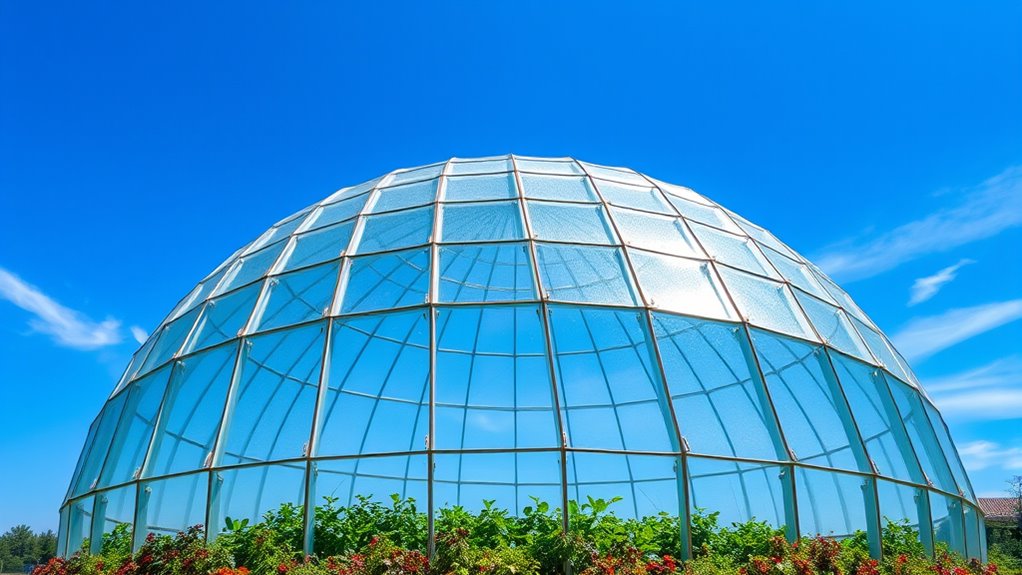
While you explore options for effective gardening, dome greenhouses stand out due to their unique geodesic design, offering a blend of strength and energy efficiency.
Their triangular elements provide exceptional stability, allowing them to withstand heavy snow and strong winds. With reduced surface area, these greenhouses minimize heat loss, maximizing energy efficiency. You’ll appreciate the space optimization, as they eliminate wasted corners, giving you more cultivation area.
Constructed with polycarbonate panels and corrosion-resistant materials, dome greenhouses ensure durability and high light transmission. They utilize passive solar technology for natural climate control, creating a stable environment for your plants.
Plus, their low maintenance requirements make them an ideal choice for sustainable gardening, allowing you to enjoy healthier plants with less effort.
Wooden Greenhouses
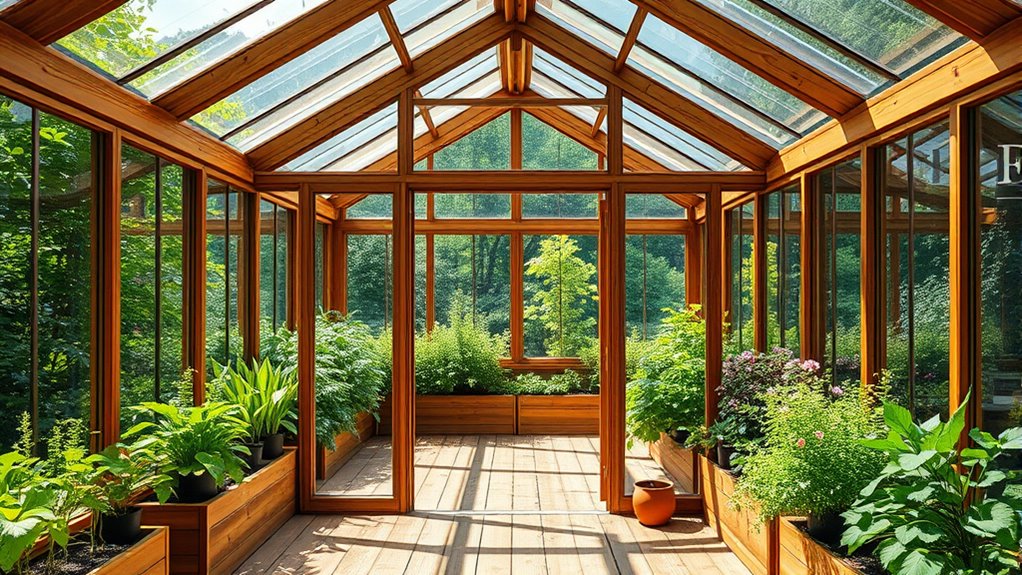
Dome greenhouses offer remarkable benefits, but wooden greenhouses present their own unique charm and functionality.
With their traditional and rustic appearance, wooden greenhouses seamlessly blend into garden landscapes. The natural insulation properties of wood help maintain a stable internal temperature, which can reduce your heating costs.
Plus, the sturdy wooden frames are thicker than metal, providing excellent stability against strong winds. You can also customize your wooden greenhouse to match your specific design preferences.
However, be mindful that they require regular maintenance to prevent rot and insect damage. While they may come with a higher price tag, their aesthetic appeal and durability make them a classic choice for many gardening enthusiasts.
Aluminum Greenhouses

Aluminum greenhouses stand out for their blend of durability and modern aesthetics, making them a popular choice among gardeners.
Weighing less than most metals, aluminum boasts a high strength-to-weight ratio, ensuring your greenhouse withstands heavy snow, wind, and rain. Plus, it’s resistant to pests and rot, requiring minimal maintenance over the years.
You’ll enjoy energy efficiency, as aluminum can be designed for optimal insulation, regulating temperature effectively. Additionally, many aluminum greenhouses are designed with energy efficiency standards in mind, helping to further reduce utility costs.
Customization options abound, allowing you to choose colors and designs that fit your garden style.
Lightweight and cost-effective, aluminum greenhouses are easy to install and transport, making them a practical choice.
With their long lifespan and low upkeep, they offer excellent value for your investment.
Hydroponic Greenhouses
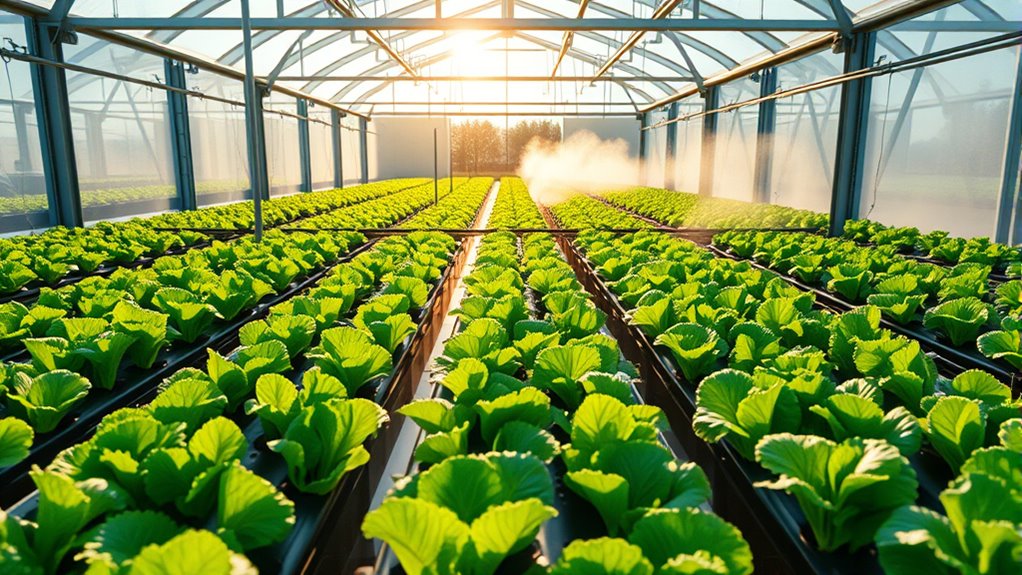
Hydroponic greenhouses offer an innovative approach to gardening that enables you to grow plants without soil, maximizing efficiency and yield.
These systems allow for year-round production, ensuring your crops thrive regardless of the weather. You’ll notice significant water conservation, using less than traditional methods, making it perfect for areas with limited water supply.
With a controlled environment, pest infestations are minimized, reducing pesticide use. You’ll also enjoy improved crop quality, as plants receive optimal nutrients, resulting in healthier produce.
Popular hydroponic systems include Deep Water Culture for leafy greens and Nutrient Film Technique for commercial settings.
Whether for urban agriculture or small-scale gardening, hydroponic greenhouses provide sustainable solutions for modern growers.
Frequently Asked Questions
How Do I Choose the Right Greenhouse for My Climate?
To choose the right greenhouse for your climate, start by assessing your local conditions.
If you live in a hot, dry area, opt for simple structures with good airflow. In humid climates, ensure proper ventilation and moisture control.
For cold regions, select heavy-duty frames with insulation. Consider materials like polycarbonate for durability or glass for light transmission.
Finally, evaluate designs that suit your space and growing needs, ensuring they can withstand local weather conditions.
What Are the Maintenance Requirements for Different Greenhouse Types?
Picture yourself strolling through your thriving greenhouse, sunlight streaming through the glass.
Each type requires specific maintenance: lean-tos need regular cleaning and pest checks, while freestanding ones demand structural inspections and ventilation upkeep.
Cold frames call for seasonal setups, and geodesic domes require advanced climate control checks.
Can I Build a Greenhouse Myself, or Should I Hire a Professional?
You can definitely build a greenhouse yourself if you’re willing to invest the time and effort.
It’ll save you money and allow for customization to fit your needs.
However, if you’re short on time or unsure about your skills, hiring a professional might be the better choice.
They ensure quality and compliance with local regulations, giving you peace of mind.
Weigh your options based on your budget, skills, and time availability.
What Plants Grow Best in Each Type of Greenhouse?
In lean-to greenhouses, herbs like basil and parsley thrive in partial shade, while freestanding greenhouses are perfect for warm-loving tomatoes and cucumbers.
Cold frames work well for cool-season crops like spinach, and geodesic domes support a variety of plants, including tropical species and fruits.
How Do I Control Pests and Diseases in My Greenhouse?
Think of your greenhouse as a fortress. To keep pests and diseases at bay, start by sealing off entry points with insect screens.
Maintain cleanliness, isolating new plants to prevent unwelcome guests. Introduce beneficial insects, like ladybugs, to fight off pests.
Use eco-friendly sprays when necessary, and regularly inspect your plants. By creating a balanced environment and practicing good sanitation, you’ll ensure your fortress thrives against invaders.
Conclusion
Choosing the right greenhouse is like planting a seed; it starts small but has the potential to grow into something beautiful. Whether you’re drawn to the elegance of a Gothic arch or the simplicity of a hoop house, each option offers a unique space for your gardening dreams. Just as every plant thrives under different conditions, find the greenhouse that nurtures your vision. Embrace the journey, and watch your green thumb flourish in the perfect environment.

